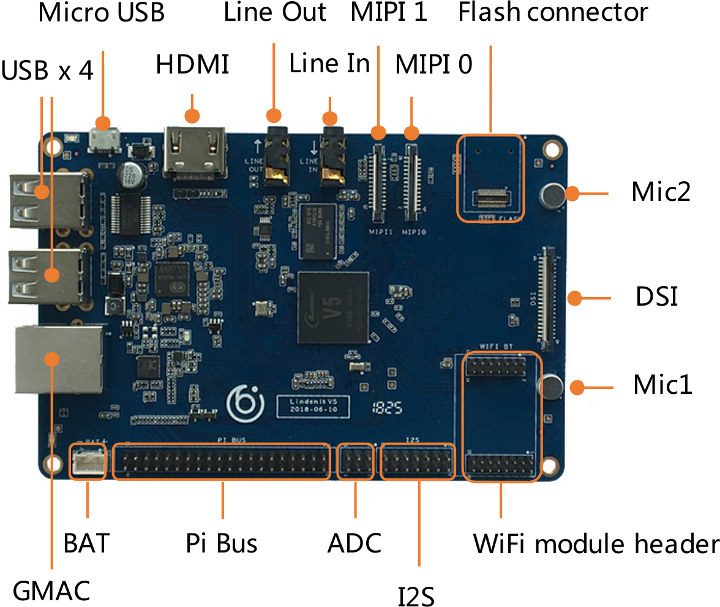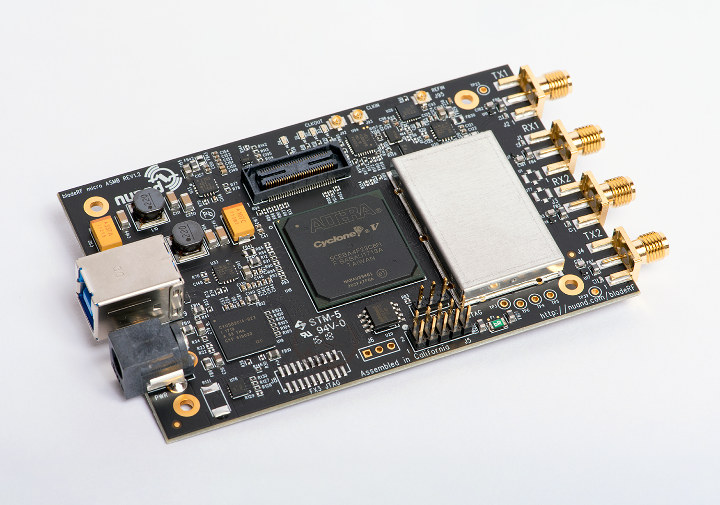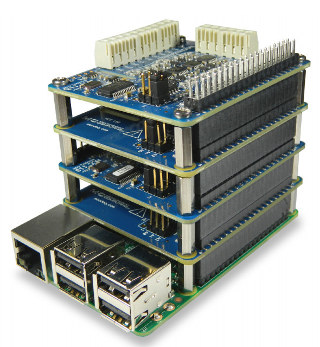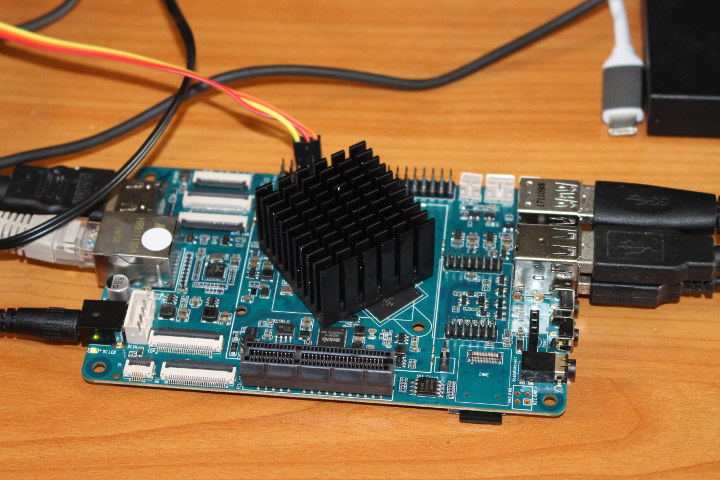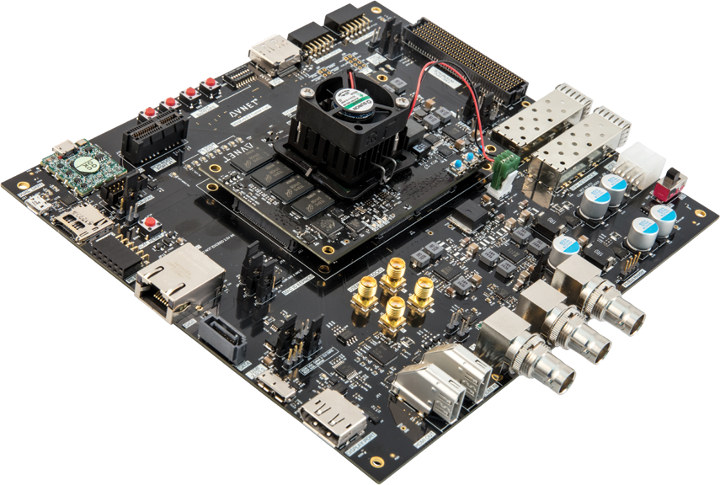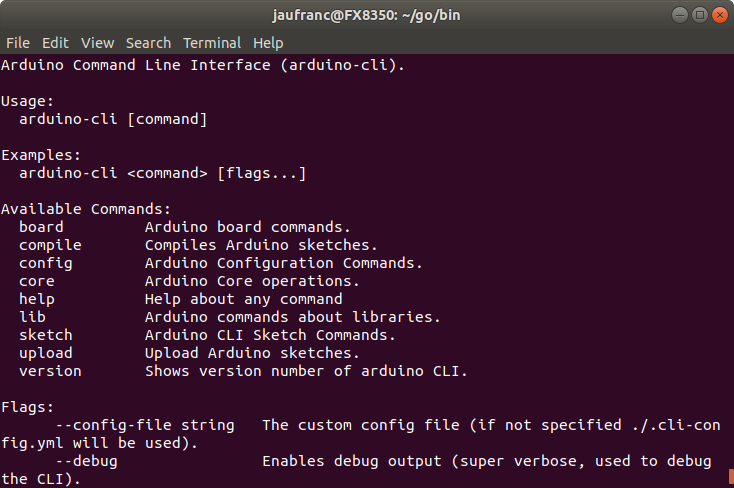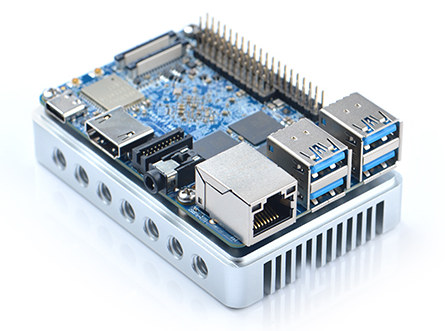Allwinner V5 V100 is a new quad core Cortex A7 processor targeting 4K 30 fps (Linux) cameras, and integrating AIE intelligent analytic acceleration engine handling motion detection, perimeter defense video diagnosis, and face detection. Usually, it’s pretty hard to get a development board based on a new processor, but Lindenis V5 single board computer based on the processor is already available in China, and comes with 1 to 2GB RAM, HDMI 1.4 and MIPI DSI video outputs, dual MIPI CSI video inputs, Gigabit Ethernet and more. Lindevis V5 SBC specifications: SoC – Allwinner V5 Quad-core Arm Cortex-A7 processor @ up to 1,512 MHz with NEON, VFPv4 FPU 4K @ 30 fps H.265/H.264 encoder and decoder Dual ISP 13M@30fps + 8M@30fps AIE (AI Engine) Architecture – Built-in with intelligent analytics acceleration engine with support for motion detection, perimeter defense, video diagnosis, face detection, flow statistics. Supports binocular depth map. System Memory […]
BladeRF 2.0 USB 3.0 Software Defined Radio Launched for $480 and Up
Around 5 years ago, several affordable FPGA based open source software defined radio boards launched including HackRF, BladeRF x40 / x115, and USRP B200. The company behind BladeRF has now launched an update of their boards with Blade RF 2.0 coming in two versions namely bladeRF 2.0 micro xA4 and bladeRF 2.0 micro xA9 supporting the same 47MHz to 6GHz frequency range, and 61.44MHz sampling rate, but the latter comes with a more powerful 301KLE Cyclone V FPGA. BladeRF 2.0 hardware specifications: FPGA Micro xA4 – Intel / Altera Cyclone V FPGA with 49 kLE Micro xA9 – Intel / Altera Cyclone V FPGA with 301 kLE Analog Devices RF Transceiver 47 MHz to 6 GHz frequency range 2×2 MIMO, 61.44 MHz sampling rate 56 MHz filtered bandwidth (IBW) Automatic gain control (AGC) Real- time custom gain control tables controlled via SPI and discrete external input pins Automatic IQ and […]
MCC 118 DAQ HAT Enables Up to 64-Channel Voltage Measurement on Raspberry Pi Boards
Measurement Computing Corp. (MCC) has recently introduced their MCC 118 DAQ HAT for Raspberry Pi which includes 8 analog inputs for voltage measurements between +/- 10V at a 100kS/s data rate. You can also perform data acquisition on up to 64 channels by stacking up to 8 MCC-118 DAQ HATs on top of a single Raspberry Pi board. The maximum throughput is limited to 320 kS/s. MCC 118 DAQ HAT key features & specifications: 8x 12-bit voltage inputs 100 kS/s max sample rate (320 kS/s aggregate for stacked boards) ±10 V input range Onboard sample buffers allow for high-speed acquisition External scan clock I/O External digital trigger input Screw terminal connections Up to eight MCC HATs are stackable on top of a Raspberry Pi board The data acquisition / data logger systems based on the add-on board would run Raspbian (Lite) on the Raspberry Pi board, as well as a […]
RockPro64 RK3399 Board Linux Review with Ubuntu 18.04 + LXDE
Let’s do one more RK3399 Linux review using Pine64 RockPro64 development board. After shortly checking out the hardware, I’ll test Ubuntu 18.04 “Bionic” LXDE on the board, test 3D graphics acceleration, video playback, USB storage and network performance among other things on the board. RockPro64 Board Unboxing The board came in a cardboard package, and the sticker made it clear I had received the 2GB LPDDR4 version. Even after FriendlyELEC NanoPi M4 announcement, Rockchip ROCKPro64 is still the cheapest RK3399 development board around, so it should come as no surprise that the board does not come with any accessories by default. Another way to keep the price low was not to include any built-in storage apart from SPI flash, so instead most people will either boot from micro SD card or an eMMC flash module both of which need to be purchase separately. Another cost-saving is the lack of built-in […]
UltraZed-EV Starter Kit Support Simultaneous 4K Encoding and Decoding with Xilinx Zynq UltraScale+ EV MPSoC
Xilinx unveiled Zynq UltraScale+ MPSoC‘s combining Arm Cortex A53/R5 cores with FPGA fabric back in 2015. and we started to see development boards and products based on the solution starting in 2017 with offerings such as AXIOM Board, TRENZ TE0808 SoM, or more recently 96Boards compliant Ultra96 development board. All last three boards have one thing in common: they all use an Zynq UltraScale+ GC MPSoC that adds a Mali-400MP2 GPU to CG MPSoC family. But there’s also a third EV family which standards for “Embedded Vision”, and adds support for 4K H.264 / H.265 hardware video codec capable of simultaneous encode and decode. The platform targets multimedia, automotive ADAS, surveillance, and other embedded vision applications. So far, I don’t think I had seen any boards based on Ultrascale+ EV MPSoC, but AVNet – following up on their UltraZed-EG starter kit – has now launched an UltraZed-EV starter kit powered […]
Arduino Releases Command Line Interface (CLI) Alpha Preview
So far, AFAIK the only official ways to program Arduino boards were through the Arduino IDE program, or the cloud-based Arduino Create which works in your web browser and does not require any installation on your computer. While graphical interfaces are nice and user-friendly, many of us are more productive while working using the command line, especially if commands can be scripted. So Arduino decided to work on a command line interface (CLI) for professional users, and have just announced a preview release. arduino-cli works in Windows, Linux, and Mac OS, and allows you install libraries, boards, and cores (e.g. esp32 Arduino core), compile the code, and upload the binary to the target board. If you want to get started quickly, you can download the binary “alpha” releases in the announcement board, but instead I opted to build the client myself as explained on Github. Everything below is done in […]
NanoPi M4 Raspberry Pi Inspired RK3399 Board Launched for $65 and Up
As expected, FriendlyELEC has now launched NanoPi M4 board, a lower cost version of NanoPC-T4 Rockchip RK3399 SBC, and mostly following Raspberry Pi form factor. How much you may ask? That would be $65 plus shipping for the 2GBRAM version, and $95 for the 4GB RAM version, which means it sells in the same ballpark as RockPro64 board. NanoPi M4 board specifications: SoC – Rockchip RK3399 big.LITTLE hexa-core processor with 2x Arm Cortex-A72 @ up to 2.0GHz, 4x Cortex-A53 @ up to 1.5GHz, a Mali-T864 GPU with support OpenGL ES1.1/2.0/3.0/3.1, OpenVG1.1, OpenCL, DX11, and AFBC, and a VPU with 4K VP9 and 4K 10-bit H265/H264 6decoding System Memory – Dual-channel 4GB LPDDR3-1866, or dual-channel 2GB DDR3-1866 Storage – eMMC module socket, micro SD card slot Video Output HDMI 2.0a up to 4K @ 60 Hz with HDCP 1.4/2.2 support 4-Lane MIPI-DSI connector Audio – 3.5mm headphone jack, HDMI digital audio […]
PiMecha Humanoid Robot Based on Raspberry Pi Sells for about $500
SB Components introduced PiMecha humanoid robot powered by a Raspberry Pi Zero (W)/ A+ / 2 / 3 (B+) board, and offering 17 degrees of freedom (DoF) on Kickstarter a few months ago. But with KS backers expecting their rewards in September, the company is now taking pre-orders on their own website for the robot for 399 GBP, or about $511 at today’s exchange rate. The company has apparently not published any detailed specifications of the robot on their website. But the robot is basically comprised of an outer shell comprised of removable metal pieces, and precise smartbus servo motors. Your chosen Raspberry Pi board would be fitted to the robot’s chest together with PiMecha shield add-on board handling the servo control. PiMecha can be easily customized with a Pi camera, an LCD display, your own sensors an so on. SB Components provide software to program the robot in order […]


